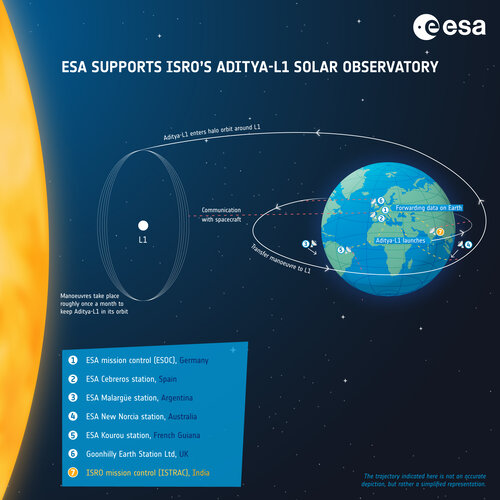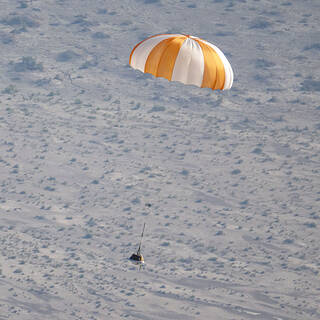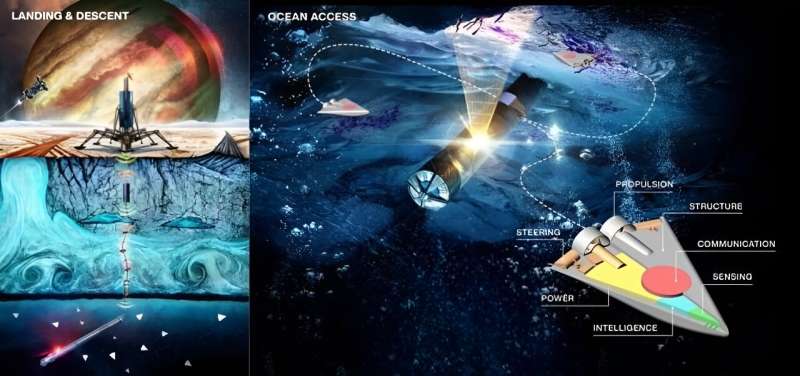
Copernical Team
Lagrange Points
 Image:
Lagrange Points
Image:
Lagrange Points How is ESA supporting ISRO’s Aditya-L1 solar mission?

A good night’s sleep in orbit

During his Huginn mission, ESA astronaut Andreas Mogensen will run two experiments focusing on sleeping in space: Circadian Light and Sleep in Orbit.
Last 'Super Blue Moon' until 2037
 Astronomy enthusiasts are in for a treat Wednesday night: a rare "super blue Moon" that won't be seen again for more than a decade.
Supermoons occur when the Moon passes through its perigee, or the point that takes it closest to Earth during its elliptical orbit. This makes it look about 14 percent bigger compared to when it is at its furthest point, and a touch brighter.
Full Moons are
Astronomy enthusiasts are in for a treat Wednesday night: a rare "super blue Moon" that won't be seen again for more than a decade.
Supermoons occur when the Moon passes through its perigee, or the point that takes it closest to Earth during its elliptical orbit. This makes it look about 14 percent bigger compared to when it is at its furthest point, and a touch brighter.
Full Moons are Picogrid, building a more open defense ecosystem, clinches $950m Air Force IDIQ contract
 Picogrid has been awarded a $950,000,000 ceiling Indefinite Delivery/Indefinite Quantity contract for the maturation, demonstration and proliferation of capability across platforms and domains, leveraging open systems design, modern software and algorithm development in order to enable Joint All Domain Command and Control (JADC2).
This multiple award contract provides awardees the opportun
Picogrid has been awarded a $950,000,000 ceiling Indefinite Delivery/Indefinite Quantity contract for the maturation, demonstration and proliferation of capability across platforms and domains, leveraging open systems design, modern software and algorithm development in order to enable Joint All Domain Command and Control (JADC2).
This multiple award contract provides awardees the opportun Northrop Grumman delivers mini laser to US Government
 Northrop Grumman Corporation (NYSE: NOC) has delivered a miniaturized high-energy laser source to the U.S. government. The laser is ruggedized for field use and miniaturizing it allows for rapid placement in tactical situations.
The 10kW class high-energy laser, known as Phantom, is about 12 cubic feet (nearly the size of a mini fridge).
Weighing less than 200 pounds, it enables lift
Northrop Grumman Corporation (NYSE: NOC) has delivered a miniaturized high-energy laser source to the U.S. government. The laser is ruggedized for field use and miniaturizing it allows for rapid placement in tactical situations.
The 10kW class high-energy laser, known as Phantom, is about 12 cubic feet (nearly the size of a mini fridge).
Weighing less than 200 pounds, it enables lift Umbra selected by AFWERX for SBIR Phase II Contract
 Umbra, a leader in advanced space radar technology, announced it has been selected by AFWERX for a SBIR Phase II contract in the amount of $1.25 million focused on Space-Based Moving Target Indication (MTI) to address the most pressing challenges in the Department of the Air Force (DAF). Umbra will leverage its market leading wide-bandwidth, affordable space systems, uniquely operating in paired
Umbra, a leader in advanced space radar technology, announced it has been selected by AFWERX for a SBIR Phase II contract in the amount of $1.25 million focused on Space-Based Moving Target Indication (MTI) to address the most pressing challenges in the Department of the Air Force (DAF). Umbra will leverage its market leading wide-bandwidth, affordable space systems, uniquely operating in paired NASA Completes Last OSIRIS-REx Test Before Asteroid Sample Delivery
 A team led by NASA in Utah’s West Desert is in the final stages of preparing for the arrival of the first U.S. asteroid sample – slated to land on Earth in September.
A team led by NASA in Utah’s West Desert is in the final stages of preparing for the arrival of the first U.S. asteroid sample – slated to land on Earth in September. A swarm of swimming microbots could be deployed to Europa's ocean

Europa and other ocean worlds in our solar system have recently attracted much attention. They are thought to be some of the most likely places in our solar system for life to have developed off Earth, given the presence of liquid water under their ice sheathes and our understanding of liquid water as one of the necessities for the development of life.
Various missions are planned to these ocean worlds, but many suffer from numerous design constraints. Requirements to break through kilometers of ice on a world far from the sun will do that to any mission. These design constraints sometimes make it difficult for the missions to achieve one of their most important functions—the search for life. But a team of engineers from NASA's Jet Propulsion Laboratory think they have a solution—send forth a swarm of swimming microbots to scour the ocean beneath a main "mothership" bot.
One of the most likely forms of the mothership bot for this mission is the Subsurface Access Mechanism for Europa—SESAME.
Sahara space rock 4.5 billion years old upends assumptions about the early solar system

In May 2020, some unusual rocks containing distinctive greenish crystals were found in the Erg Chech sand sea, a dune-filled region of the Sahara Desert in southern Algeria.
On close inspection, the rocks turned out to be from outer space: lumps of rubble billions of years old, left over from the dawn of the solar system.
They were all pieces of a meteorite known as Erg Chech 002, which is the oldest volcanic rock ever found, having melted long ago in the fires of some now-vanished ancient protoplanet.
In new research published in Nature Communications, we analyzed lead and uranium isotopes in Erg Chech 002 and calculated it is some 4.56556 billion years old, give or take 120,000 years. This is one of the most precise ages ever calculated for an object from space—and our results also cast doubt on some common assumptions about the early solar system.
The secret life of aluminum
About 4.567 billion years ago, our solar system formed from a vast cloud of gas and dust.

